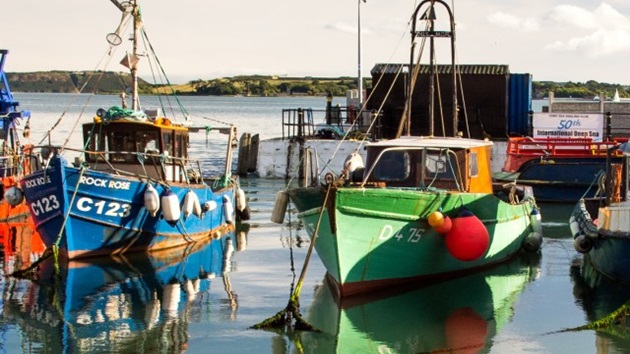
As concerns over climate change and questions about seafood sustainability grow, it is very important that families—especially those who eat seafood—discuss the ocean’s health and how their purchasing choices can have a large, positive impact on our blue planet.
We've collected five questions sustainable seafood skeptics commonly ask and created fact-based conversation points you can reply with:

Is overfishing really a problem?
Unfortunately, the answer is yes. However, there is a solution that you can be a part of.
Overfishing occurs when the rate of fishing is higher than the rate at which fish reproduce and repopulate. Overfishing is unsustainable and poses a serious threat to our ocean’s health and the marine environment: currently, over 1/3 of the world’s global fisheries are overfished (SOFIA, 2020).
Overfishing has a negative impact not only on fish that are targeted for harvesting but other marine life (often called bycatch) and marine habitats that interact with fishing activities and vessels. If overfishing continues trending this way, there will not be enough fish left in the ocean to keep marine ecosystems balanced and future generations fed.
A recent analysis by MSC scientists shows we are currently missing out on enough protein for 72 million more people every year because fisheries have not been managed with long-term yield in mind. However, if sustainable fishing practices are adopted globally, we could feed more people for a longer time.
It is the responsibility of all seafood consumers to better understand this global issue, as well as to explore the ways that they can help.
Continue the Conversation → When discussing overfishing, address solutions that can help - like diversifying the types of seafood consumed in your diets; this can help lessen the pressure of fishing on popular species, like tuna and salmon. Read more info on biodiversity here.
Is eating seafood bad for the environment?
Unsustainable fishing is bad for the environment, not the action of eating seafood.
In fact, by making the switch to wild sustainably caught seafood you can build a more overall planet-friendly diet. Unlike land-based proteins, wild-caught seafood does not emit large quantities of methane gas (produced by livestock) or nitrous oxide (released from tilled and fertilized soils), both of which are many times more potent than carbon dioxide.
Because wild-caught seafood doesn’t typically require feed or dedicated land like agriculture or livestock farming, it has one of the lowest carbon footprints of animal-based protein sources around the world.
The best thing to do to support the health of our ocean is not to simply stop eating seafood. Rather, you can make the switch to ocean-friendly certified sustainable wild-caught (or responsibly farmed!) options.
Continue the Conversation → Highlighting how our diet choices impact our planet is important. See how a sustainability-minded foodie weighs in on this new trend of "voting with your fork" in her guest blog: Can Going Pescatarian Save the Planet?
Can blue food help feed a growing global population?
The global population is rising and is set to reach 10 billion by 2050 and feeding a growing population requires innovative, sustainable solutions. Blue foods—fish, shellfish, aquatic plants, and algae, or foods caught or cultivated in freshwater and marine environments—are becoming a hot topic for professionals and policymakers discussing food security over the next few years and decades. The concept of “blue foods” as a real food solution is supported by the recently released Blue Food Assessment report.
Following the release of this report, the UN Food Systems Summit recently highlighted that “Blue food transformation will not only increase the supply of nutritious food but also contribute to community resilience, good jobs, gender equity, and poverty alleviation. Thus, enhanced attention to this critical component of the planet’s food production and nutrition system will provide essential support to the mission of the Coalition of Action for Zero Hunger.”
However, the peer-reviewed papers make it clear that to achieve these goals, it is vital to ensure that fish stocks are sustainably and effectively managed. As the global demand for seafood grows, the risk that more of the world’s fish stocks will be overfished increases.
Despite this recent attention by the United Nations and world leaders, blue foods are often left out of global food security discussions. Seafood is often managed as a natural resource, and not as a critical component of nutritious, sustainable, and equitable food systems.
Continue the Conversation → If your family is passionate about food, share what sustainable food systems they can choose to support the growing global population’s livelihoods and proper nutritional needs, and why sustainable seafood needs to be a part of the larger food security conversation.
How do I know if the seafood I’m purchasing is sustainable?
Shoppers are increasingly looking for reliable ways to determine if the products that they’re purchasing are aligned with their values. However, with a growing sea of claims including “sustainable,” “responsible,” or “ocean-friendly” seafood, how can you know which to trust?
While shopping or dining out, a surefire way to find a specific product that has come from a sustainable fish stock is to look out for independent certification ecolabels, like the MSC blue fish label on wild-caught seafood and ASC label on responsibly farmed aquaculture products.
What sets these labels apart from other sustainability claims?
These certifications assess the sustainability of a particular stock (or population of fish) rather than making a larger blanket statement on which species are okay to eat vs. should be avoided. This provides assurance to the seafood consumer—you!—that the specific product you are purchasing has been caught sustainably and further supports sustainable fishing globally.
If you cannot find a label or are unsure about a seafood product, ask the person working at the fish counter or the store manager if the seafood comes from a certified sustainable fishery or check the retailer’s website to read their sustainable seafood sourcing policies.
Continue the conversation → Prompt your family to do some digging on what the labels on their seafood packaging represent and to ask important questions about how their seafood is being sourced, including whether local seafood is always the most sustainable.
How can I know that the MSC blue fish label is not “greenwashing”?
Greenwashing is an intentionally misleading marketing tactic that allows consumers to believe a given product is more environmentally friendly than it is. The MSC blue fish label promises to connect consumers with wild-caught seafood sourced from an MSC-certified sustainable fishery—and it does just that.
The MSC blue fish label represents over 20 years of science-backed collaboration and progress between policymakers, commercial fisheries, seafood retailers, and governments. Over the course of the last few decades, the MSC program has resulted in over 1,950 proven impacts delivered by fisheries on the water and beyond, including reduction of bycatch and improved management.
There are four key criteria that define an effective and credible sustainability label:
- The label is an independent certification – The Marine Stewardship Council (MSC) is an independent nonprofit that sets the sustainability standards by which fisheries (MSC Fisheries Standard) and companies (MSC Chain of Custody Standard) can have their practices assessed against. The MSC is not responsible for assessing or certifying fisheries, which allows it to remain impartial in the standard development process.
- Assessments are performed by independent, third-party auditors – The same company that creates a label or claim should not be the one assessing whether the applicant is approved. Third-party programs—like the MSC—offer the highest level of assurance that the outcomes of assessments are unbiased.
- The product has been verified along the supply chain – Seafood fraud, which is the misrepresentation or mislabeling of a seafood product as something it’s not, is a major problem across North America. Sometimes this mislabeling occurs by mistake due to mismanagement along the supply chain, which is why the MSC requires every product to have Chain of Custody – ensuring all products with the MSC blue fish label are kept separate from non-certified seafood, can be traced back to an MSC certified fishery and are correctly labeled.
- Program impacts and progress can be measured – A great indicator for whether a sustainability claim is valid or trustworthy is to explore its proven impacts. The organization should also readily publish these impacts for public review. The MSC uses specific scientific criteria to measure the impacts of its ecolabeling program on overall fishery and ocean health.
Continue the Conversation → If something you are purchasing is making a claim about its environmental impacts, do some research to see what those impacts are and how it's being measured. Learn more about the resilience and impact of MSC certified fisheries in the face of COVID and beyond.
Building a big blue future is certainly possible within our lifetime, but only if we start having these conversations now and taking the necessary steps to support our ocean’s health.
Share what you’ve learned about overfishing, sustainability, and blue foods with family, friends, and your social networks, then look for the MSC blue fish label to identify sustainably wild-caught seafood near you. If you have additional questions or want to learn more about certified sustainable seafood, check out our “Frequently Asked Questions” webpage.

